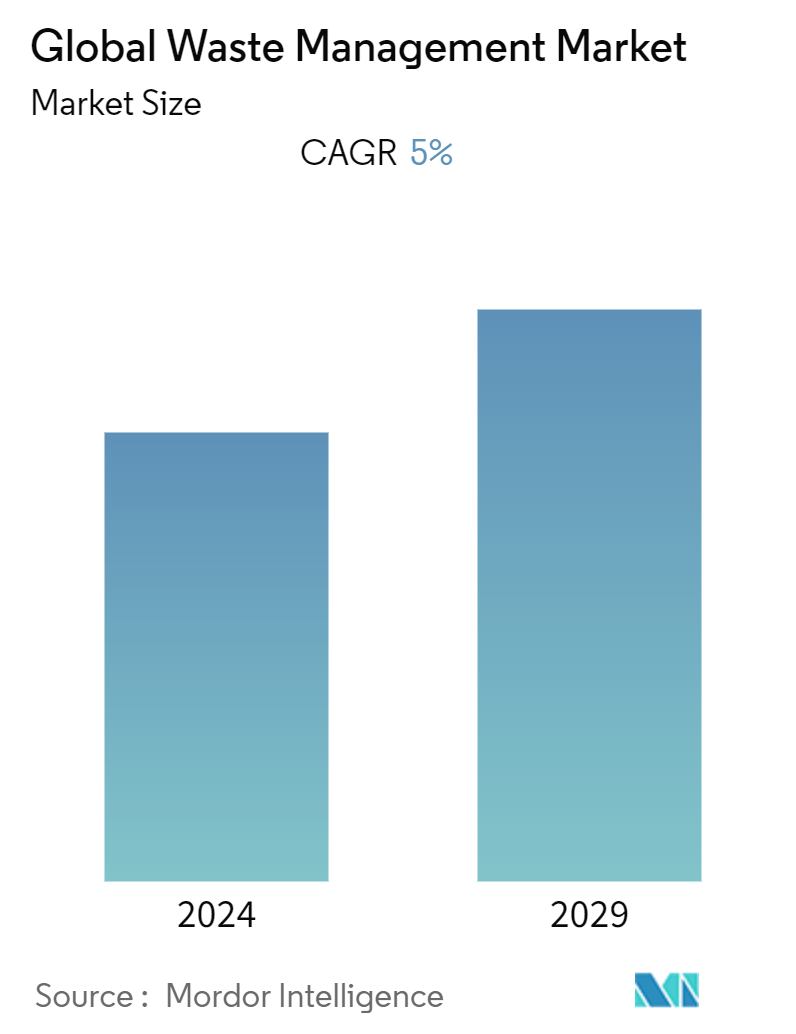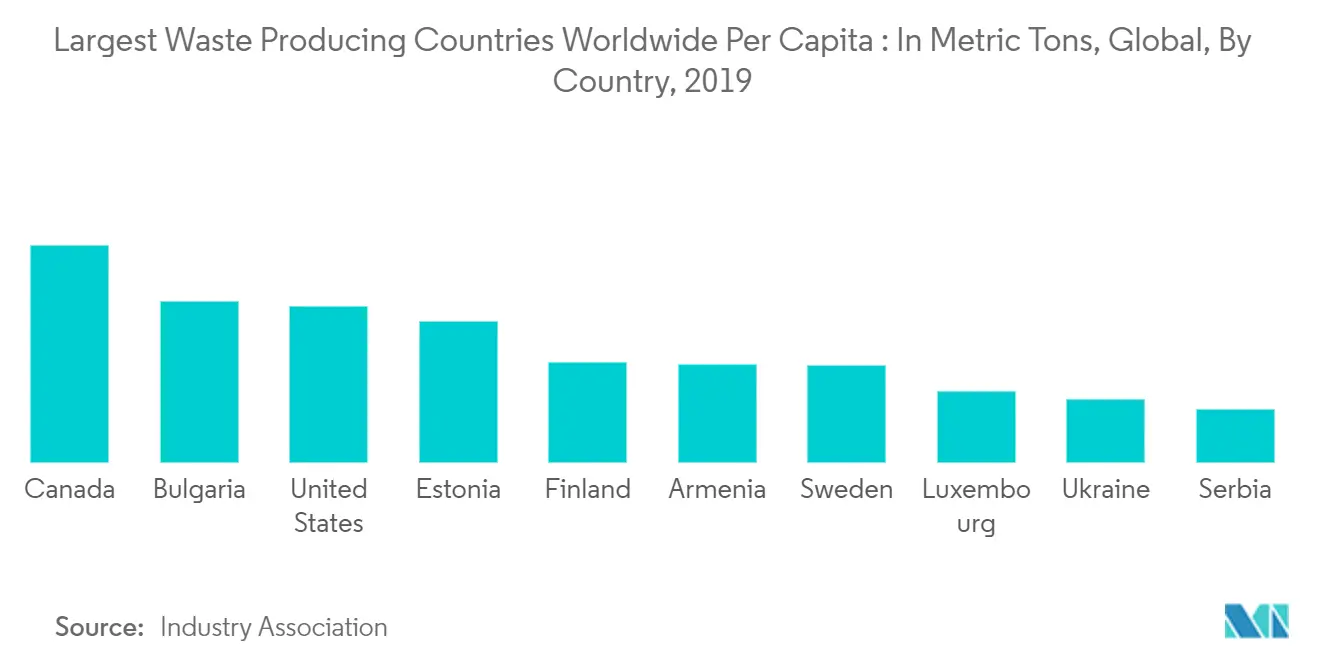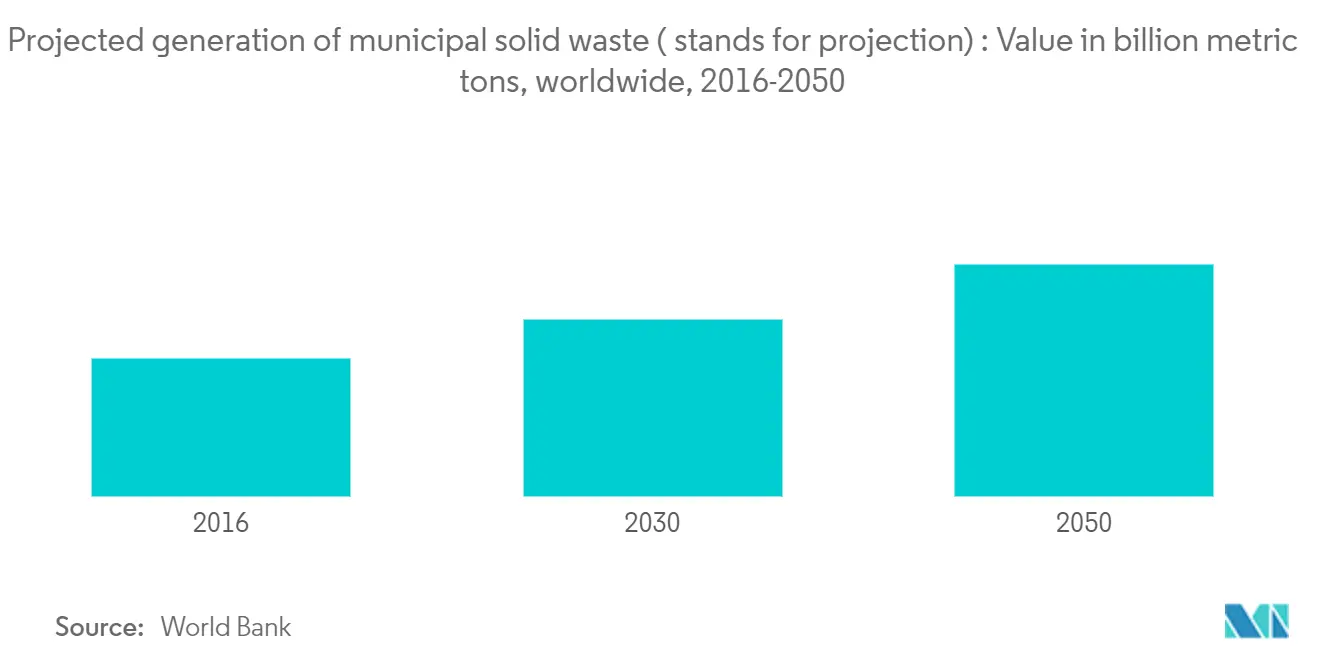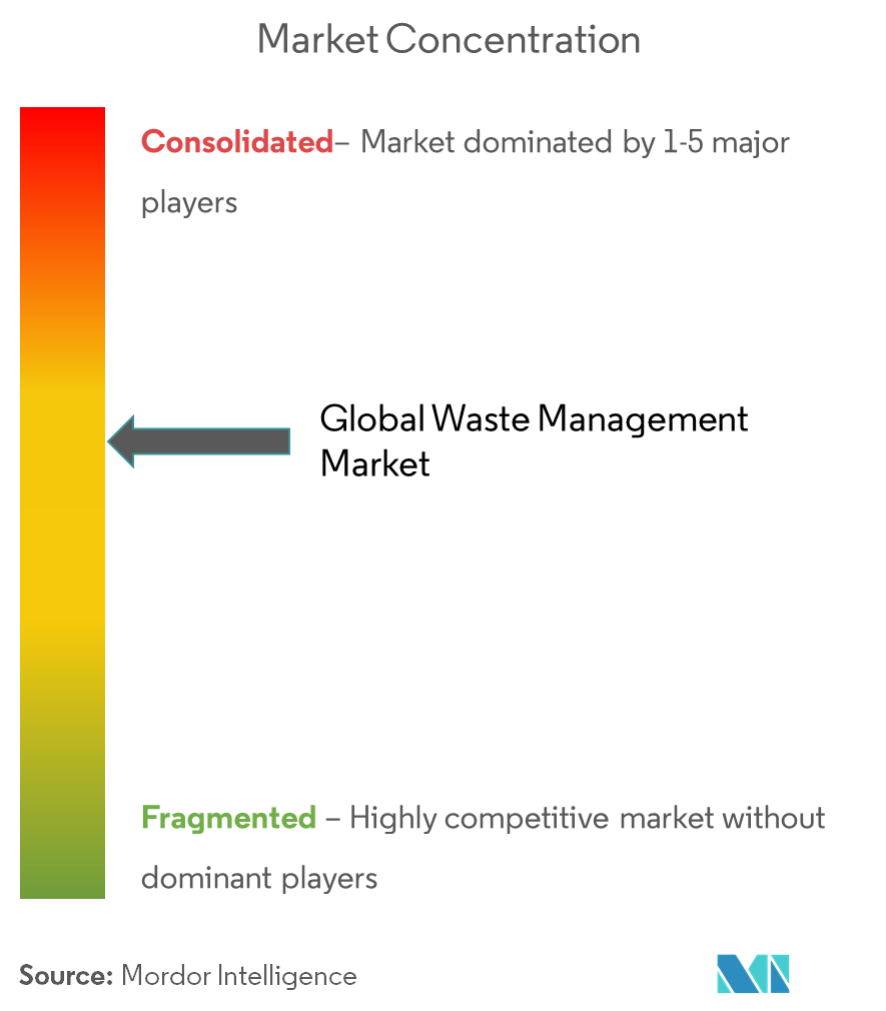Waste Management Market Size

| Study Period | 2019 - 2029 |
| Base Year For Estimation | 2023 |
| CAGR (2024 - 2029) | 5.00 % |
| Fastest Growing Market | Asia Pacific |
| Largest Market | North America |
| Market Concentration | Medium |
Major Players
*Disclaimer: Major Players sorted in no particular order |
Waste Management Market Analysis
The Global Waste Management Market is expected to register a CAGR of 5% during the forecast period.
Rapidly growing economies, urbanization and the increasing population have led (materially intensive) to an increase in resource consumption, and consequently the release of large amounts of waste into the environment. Observing from a global perspective, current waste and resource management lacks a holistic approach which covers the whole chain of product design, raw material extraction, production, consumption, recycling and waste management. A scarcity of land for effective waste disposal and focus on energy and resource recovery is driving the waste management industry’s growth. On the other hand, lower sustainability in the waste management sector and low focus on waste management are restricting the waste management industry growth. In addition, the rise in the purchase of recyclable products is providing immense opportunities for global waste management market growth. The growth of the waste management market size is driven by an increase in the adoption of proactive government measures to reduce illegal dumping.
COVID-19 impacted the garbage industry from the focus of segment shift; during the lockdown, the residential segment generated more amount of waste than industrial and commercial centers, as industries and offices were partially or completely shut. However, reviving economies and resuming production activities along with start of vaccination drives in numerous countries will increase the amount of waste generation and lead to re-initiation of waste recycle industry and waste management companies at their full-scale capacity, potentially affecting the waste management market share.
Waste Management Industry Trends
Spotlight on the Construction and Demolition waste management systems
At present, construction and demolition waste is growing healthily. Its management involves various activities such as monitoring, collecting, transporting, recycling, and disposing of the waste generated during construction, renovation, or demolition of buildings or any other infrastructure. It assists in minimizing and re-using waste materials such as concrete, soil, wood, glass, plastic, cardboard, and metal during construction activities. Unlike residential waste, construction and demolition waste materials are inert, heavy, and non-biodegradable. Hence, regulatory authorities require commercial facilities for sorting, treating, and filtering these materials before they can be reused or decomposed. Increased construction and demolition activities are catalyzing the demand for the construction and demolition waste management sector worldwide, thus impacting the waste management market share. Construction and demolition activities produce large amounts of concrete, wood, plastic, and metal waste. As improper disposal of these materials results in the emission of GHGs, environmental degradation, and deterioration of the overall health of people, the adoption of construction and demolition waste management practices has been gaining popularity all over the world.

Growth in Global Waste
As per waste management industry trends, 2.01 billion tons of municipal solid waste is generated per year at the global level, with at least 33% of that-extremely conservatively-not managed in an environmentally safe manner. Worldwide, waste generated per person per day averages 0.74 kilograms but ranges widely, from 0.11 to 4.54 kilograms. Though they only account for 16% of the world's population, high-income countries generate about 34%, or 683 million tons, of the world's waste.
In many countries, solid waste management operations are a local responsibility, and nearly 70% of countries have established institutions with responsibility for policy development and regulatory oversight in the waste management sector. About two-thirds of countries worldwide have created targeted legislation and regulations for solid waste management, though enforcement varies drastically.
Global waste management industry is expected to grow to 3.40 billion tons by 2050, greater than double population growth over the same period. Overall, there is a positive correlation between waste generation and income level. Daily per capita waste generation in high-income countries is anticipated to increase by 19% by 2050 compared to low- and middle-income countries, where it is expected to increase by approximately 40% or more. The total quantity of waste generated in low-income countries is expected to increase by greater than three times by 2050.

Waste Management Industry Overview
The waste management industry is highly competitive with many players focused on the innovative technologies to recycle and reuse the waste generated across various industries and households across the globe. There are also several startups coming up in the garbage industry that are continuously focusing on waste reduction following the Zero Waste - 3R (Reduce, Reuse, and Recycle) philosophy.
Waste Management Market Leaders
-
Clean Harbors
-
Biffa
-
Covanta Energy
-
Daiseki Co., Ltd.
-
Hitachi Zosen Corporation
*Disclaimer: Major Players sorted in no particular order

Waste Management Market News
- February 2021: Biffa group announced the acquisition of Company Shop Group ('CSG'), the UK's leading and largest redistributor of surplus food and household products.
- October 2020: Waste Management completed its acquisition of all outstanding shares of Advanced Disposal, following the receipt of required regulatory approvals. The previously announced purchase price of USD 30.30 per share in cash represents a total enterprise value of USD 4.6 billion when including approximately USD 1.8 billion of Advanced Disposal's net debt.
Waste Management Market Report - Table of Contents
1. INTRODUCTION
- 1.1 Study Assumptions and Market Definition
- 1.2 Scope of the Study
2. RESEARCH METHODOLOGY
3. EXECUTIVE SUMMARY
4. MARKET INSIGHTS and DYNAMICS
- 4.1 Market Overview
- 4.2 Insights into Technological Advancements and Innovation in Effective Waste Management
- 4.3 Industry Attractiveness - Porter's Five Forces Analysis
- 4.4 Value Chain/Supply Chain Analysis
- 4.5 Insights on Strategies of Rising Startups Venturing into the Global Waste Management Industry
- 4.6 Spotlight on Market Trends
- 4.7 Impact of COVID-19 on the Market
5. MARKET DYNAMICS
- 5.1 Market Drivers
- 5.2 Market Restraints
- 5.3 Market Opportunities
6. MARKET SEGMENTATION (Market Size by Value and Volume)
-
6.1 By Waste type
- 6.1.1 Industrial waste
- 6.1.2 Municipal solid waste
- 6.1.3 E-waste
- 6.1.4 Plastic waste
- 6.1.5 Biomedical and Other Waste Types
-
6.2 By Disposal methods
- 6.2.1 Landfill
- 6.2.2 Incineration
- 6.2.3 Recycling
-
6.3 Geography
- 6.3.1 North America
- 6.3.1.1 United States
- 6.3.1.2 Canada
- 6.3.2 Europe
- 6.3.2.1 United Kingdom
- 6.3.2.2 Germany
- 6.3.2.3 France
- 6.3.2.4 Russia
- 6.3.2.5 Rest of Europe
- 6.3.3 Asia-Pacific
- 6.3.3.1 China
- 6.3.3.2 Japan
- 6.3.3.3 India
- 6.3.3.4 South Korea
- 6.3.3.5 Rest of Asia-Pacific
- 6.3.4 Middle East & Africa
- 6.3.5 Latin America
7. INVESTMENT ANALYSIS IN GLOBAL WASTE MANAGEMENT INDUSTRY
8. COMPETITIVE LANDSCAPE
- 8.1 Overview (Market Concentration and Major Players)
-
8.2 Company Profiles
- 8.2.1 Biffa Group
- 8.2.2 Clean Harbors, Inc.
- 8.2.3 Covanta Holding Corporation
- 8.2.4 Veolia Environment SA
- 8.2.5 Waste Connections
- 8.2.6 Remondis AG & Co. Kg
- 8.2.7 Suez Environment S.A.
- 8.2.8 Daiseki Co. Ltd
- 8.2.9 Waste Management Inc.
- 8.2.10 Republic Services
- 8.2.11 Averda*
- *List Not Exhaustive
9. MARKET OPPORTUNITIES AND FUTURE TRENDS
10. APPENDIX
11. DISCLAIMER AND ABOUT US
** Subject To AvailablityWaste Management Industry Segmentation
The waste management (or waste disposal) market includes the activities and actions required to manage waste from its inception to its final disposal. This includes the collection, transport, treatment, and disposal of waste, with monitoring and regulation of the waste management process.
The report offers a complete background analysis of the global waste management market, which includes an assessment of the economy and contribution of sectors in the economy, waste management industry overview, waste management market size estimation for key segments, and emerging waste management industry trends in the market segments, and market dynamics. The report also covers the impact of COVID-19 on the garbage industry.
The report is segmented by waste type (Industrial waste, Municipal solid waste, Hazardous waste, E-waste, Plastic waste, and Bio-medical waste), by Disposal methods (Landfills, Incineration, and Recycling), and by Geography (North America, Europe, Asia-Pacific, and LAMEA). For each segment, the waste management market size and forecasts are based on volume (tons) and value (USD billion).
| By Waste type | Industrial waste | |
| Municipal solid waste | ||
| E-waste | ||
| Plastic waste | ||
| Biomedical and Other Waste Types | ||
| By Disposal methods | Landfill | |
| Incineration | ||
| Recycling | ||
| Geography | North America | United States |
| Canada | ||
| Geography | Europe | United Kingdom |
| Germany | ||
| France | ||
| Russia | ||
| Rest of Europe | ||
| Geography | Asia-Pacific | China |
| Japan | ||
| India | ||
| South Korea | ||
| Rest of Asia-Pacific | ||
| Geography | Middle East & Africa | |
| Latin America |
Waste Management Market Research FAQs
What is the current Global Waste Management Market size?
The Global Waste Management Market is projected to register a CAGR of 5% during the forecast period (2024-2029)
Who are the key players in Global Waste Management Market?
Clean Harbors, Biffa, Covanta Energy, Daiseki Co., Ltd. and Hitachi Zosen Corporation are the major companies operating in the Global Waste Management Market.
Which is the fastest growing region in Global Waste Management Market?
Asia Pacific is estimated to grow at the highest CAGR over the forecast period (2024-2029).
Which region has the biggest share in Global Waste Management Market?
In 2024, the North America accounts for the largest market share in Global Waste Management Market.
What years does this Global Waste Management Market cover?
The report covers the Global Waste Management Market historical market size for years: 2019, 2020, 2021, 2022 and 2023. The report also forecasts the Global Waste Management Market size for years: 2024, 2025, 2026, 2027, 2028 and 2029.
What are the segments of the Waste Management Market?
The segments of the Waste Management Market are a) Waste Type: Industrial waste, Municipal solid waste, Hazardous waste, E-waste, Plastic waste, Bio-medical waste b) Disposal Methods: Landfills, Incineration, Recycling
What are the major regulatory trends impacting the Waste Management Industry?
The major regulatory trends impacting the Waste Management Industry are a) Promoting waste prevention and boosting recycling and reuse b) Focus on compostable and biodegradable materials
Waste Management Industry Report
The global solar photovoltaic (PV) market is witnessing substantial growth, driven by technological advancements and broadening adoption across various sectors. The market segmentation includes components, materials, cell types, installation types, and applications, serving a wide range of needs from residential to utility-scale projects. Innovations such as perovskite solar cells, tandem solar cells, and bifacial solar panels are enhancing the efficiency and cost-effectiveness of solar solutions. Additionally, the integration of advanced manufacturing techniques and AI is optimizing solar installations.
Despite challenges like high initial costs and the demand for skilled installation personnel, supportive government policies and incentives are propelling robust market growth. The Asia Pacific region is expected to experience rapid growth due to strong governmental support and the presence of key market players, highlighting its potential for future developments in the photovoltaic industry. Key segments such as solar PV panels are gaining popularity, underscoring the dynamic nature of the industry.
The industry report covers detailed market analysis, including market data, market segmentation, and market trends. It provides an industry outlook with insights into industry statistics, industry size, and industry growth rate. The market forecast and market predictions offer a comprehensive overview of market growth and market value, helping stakeholders understand the market dynamics. The report also includes industry research and industry information, making it a valuable resource for research companies and market leaders.
For those interested in a deeper dive, the report example and report PDF are available for download, offering extensive industry analysis and market review. The market overview and market outlook sections provide a clear picture of the current state and future potential of the solar photovoltaic market. With market leaders driving innovation and growth, the industry trends and industry sales data reflect the evolving landscape of this rapidly expanding market.



